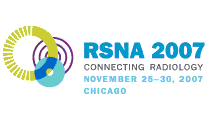
Abstract Archives of the RSNA, 2007
Marcin Hartel MD, Abstract Co-Author: Nothing to Disclose
Maciej Maciejowski MD, PhD, Abstract Co-Author: Nothing to Disclose
Aleksandra Ilona Kieltyka MD, Abstract Co-Author: Nothing to Disclose
Maria Dziubinska-Basiak MD, Abstract Co-Author: Nothing to Disclose
Tomasz Banasik MSc, Presenter: Nothing to Disclose
Magdalena Wicher, Abstract Co-Author: Nothing to Disclose
Lukasz Liszka, Abstract Co-Author: Nothing to Disclose
Marek Nikodem Konopka MD, Abstract Co-Author: Nothing to Disclose
Jacek Brzezinski MD, PhD, Abstract Co-Author: Nothing to Disclose
Marcin Pawel Basiak MD, Abstract Co-Author: Nothing to Disclose
Andrzej Wajgt MD, PhD, Abstract Co-Author: Nothing to Disclose
et al, Abstract Co-Author: Nothing to Disclose
et al, Abstract Co-Author: Nothing to Disclose
Optic neuritis (ON) is relatively often the first stage of multiple sclerosis (MS). The goal of this study is to prove that early and advanced MRI diagnostics may be useful to identify ON patients whose symptoms will proceed into next stages of MS for their earlier treatment.
17 patients with ON were scanned with magnetic resonance imaging (MRI) with the sequences for MS diagnostics (SE T1, SE PD/T2, FLAIR, SE T1 post contrast) and sequences with and without impulse of magnetization transfer (MT) within optic nerves and brain and diffusion tensor imaging (DTI) of the brain. Clinical data and the results of standard MRI suggested to divide patients into SM and ON groups. Mean magnetization transfer ratio (MTR) was calculated within the brain and optic nerves with and without inflammatory process. 10 regions of interest (ROI) were defined in the periventricular white matter (WM) and optic tract where mean MTR, apparent diffusion coefficient (ADC) and fractional anisotropy (FA) values were calculated. The statistical analysis was performed to prove correlation between clinical state and mean optic nerves/brain MTR and values of MTR, ADC and FA within the ROIs.
Mean MTR in optic nerve with ON was significantly lower comparing with the other side. MTR values in subsequent slices of the nerve were markedly and gradually lowering to the slice with inflammation focus (which was or was not seen with the use of standard MR imaging) and later gradually raised. Mean brain/optic nerve MTR did not correlated with the clinical state of the patients. FA and ADC values were abnormal, however with no statistical significance.
Mean MTR within optic nerve was significantly abnormal and lower at the pathology side. Low number of patients did not allow to show statistically significant differences between SM and ION groups analyzing MTR values of inflamed optic nerves, brain MTR or the values measured within ROIs. We plan further studies to prove the usefulness of above techniques in diagnostics of early stages of MS.
Early and advanced MRI may be useful to identify ON patientis whose symptoms will proceed into next stages of MS to treat them earlier to reduce and delay their symptoms.
Hartel, M,
Maciejowski, M,
Kieltyka, A,
Dziubinska-Basiak, M,
Banasik, T,
Wicher, M,
Liszka, L,
Konopka, M,
Brzezinski, J,
Basiak, M,
Wajgt, A,
et al, ,
et al, ,
Advanced Magnetic Resonance Techniques in Diagnostics of Optic Neuritis to Identify Early Stages of Multiple Sclerosis: Preliminary Report. Radiological Society of North America 2007 Scientific Assembly and Annual Meeting, November 25 - November 30, 2007 ,Chicago IL.
http://archive.rsna.org/2007/5013759.html

